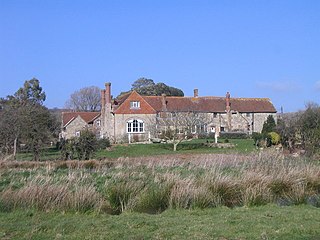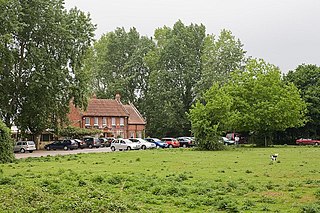
Dibden is a small village in Hampshire, England, which dates from the Middle Ages. It is dominated by the nearby settlements of Hythe and Dibden Purlieu. It is in the civil parish of Hythe and Dibden. It lies on the eastern edge of the New Forest in a valley, which runs into Southampton Water.

Kingston Lisle is a village and civil parish in the Vale of White Horse, England, about 4 1⁄2 miles (7 km) west of Wantage and 5 miles (8 km) south-southeast of Faringdon. The parish includes the hamlet of Fawler, about 1⁄2 mile (800 m) west of Kingston Lisle village. The 2011 Census recorded the parish population as 225.

South Charford is a hamlet in the New Forest district, in Hampshire, England. It is in the civil parish of Breamore on the west bank of the River Avon.

Ellingham is a small village near Ringwood in Hampshire, England, west of the New Forest National Park. It is in the civil parish of Ellingham, Harbridge and Ibsley. Ellingham is most famous for the story of Alice Lisle, who was executed by the infamous Judge Jeffreys in 1685, on the charge of harbouring fugitives after the defeat of the Monmouth Rebellion.

Haseley Manor is a 14th-century, Grade 2* listed property located in Arreton on the Isle of Wight.

Rockford is a hamlet on the western edge of the New Forest National Park of Hampshire, England. Its nearest town is Ringwood, which lies approximately 1.8 miles (2.9 km) south from the hamlet. It is in the civil parish of Ellingham, Harbridge and Ibsley.

The Great Budbridge Manor is a manor house just south of Merstone, near Arreton, Isle of Wight, England. Fish ponds on the grounds appear medieval.
Cleaveland Manor is a manor house on the Isle of Wight, situated within the Victoria parish.
Holloway Manor was a manor house on the Isle of Wight, situated within the Newchurch parish. It lies just to the north of Ventnor. It was held of the honour of Carisbrooke Castle and formed part of the estate of John de Lisle in the Island at the end of the 13th century. It followed the descent of South Shorwell until 1641, when it is mentioned for the last time. It is probably the same as the modern Ventnor Manor, which is mentioned for the first time in 1755 and then belonged to the Pophams of South Shorwell. Nearly all the land in Ventnor was sold in 1820 by the Hill family to John Hamborough and building speculators, and the manor no longer exists. Holloway can now only be identified by the Holy Well spring on the down, from which possibly the holding derived its name. In a dispute as to boundaries in 1617, witnesses deposed that Ventnor, Littletown and Holloway were tithings of themselves and that Sir Edward Dennis' ancestors kept court and law day at Holloway, where his tenants did suit royal.
Princelet Manor, is a manor house on the Isle of Wight, situated in the Newchurch parish. It a small holding to the south-west of Apse Heath, and was held by the Lisles of Wootton. Of them it was held by the Kingstons of Kingston until the middle of the 14th century. It was held in 1428 by Richard Hearn and John Mayhew. Princelet was purchased at the end of the 16th century by Richard Gard, who in 1617 left an annuity issuing out of it to the poor of Newchurch. In 1780 John White paid a fee-farm rent for it, but in 1837 it was owned by William Thatcher; the owner as of 1912 was Mr. Charles Allen.
Wackland Manor, is a manor house on the Isle of Wight, situated in the Newchurch parish. It was held in the 13th century under the Lisles of Wootton, but in 1311–12 was said to be held of Ralph de Gorges of Knighton Gorges Manor. At the end of the 13th century it was held by John de la Brigge, from whom it passed with Bridge Court (q.v.) to the Kingstons. It followed the descent of Kingston until 1424, when Robert Dingley and Lewis Meux conveyed it to John Taillour, who was returned in 1431 as holding Wackland. Its descent has not been traced from that time until the end of the 18th century. Some time before 1786 it must have been in the possession of Thomas Davis, as he left a charge of 20s. upon it for charities. In the early part of the 19th century Wackland was the residence of a hunting farmer, well known as 'Squire' Thatcher, who kept and hunted a pack of harriers. Mr. E. Carter was lord of Wackland in 1878, and as of 1912 it belonged to the trustees of the late Mr. Thomas F. Perrott.

Wolverton Manor is a manor house in Shorwell, on the Isle of Wight, England. The original house was started by John Dingley, Deputy Governor of the Isle of Wight. The Jacobean style home, built by Sir John Hammond after the death of Sir John Dingley, is the second house built on the site. There is a two-storey porch which features a flat roof and hollow angle columns.
Briddlesford Manor, is a manor house on the Isle of Wight, situated in the parish of Arreton.
Horringford Manor is a manor house on the Isle of Wight, situated in the parish of Arreton.
Rookley Manor is a manor house on the Isle of Wight, situated in the parish of Arreton. Though originally in Godshill parish, it is now included for the greater part in the boundaries of South Arreton.
Adgestone Manor is a manor house in Brading on the Isle of Wight.
Alverstone Manor is a manor house in Alverstone in the parish of Brading on the Isle of Wight.
Hardingshute Manor is a manor house in the parish of Brading on the Isle of Wight.
Park Manor is a manor house in the parish of Brading on the Isle of Wight.
Bonchurch Manor is a manor house on the Isle of Wight, situated in the parish of Bonchurch.









